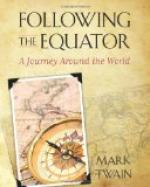He was not a liar; but he will become one if he keeps on. He told me once that he used to crack cocoanuts with his teeth when he was a boy; and when I asked how he got them into his mouth, he said he was upward of six feet high at that time, and had an unusual mouth. And when I followed him up and asked him what had become of that other foot, he said a house fell on him and he was never able to get his stature back again. Swervings like these from the strict line of fact often beguile a truthful man on and on until he eventually becomes a liar.
His successor was a Mohammedan, Sahadat Mohammed Khan; very dark, very tall, very grave. He went always in flowing masses of white, from the top of his big turban down to his bare feet. His voice was low. He glided about in a noiseless way, and looked like a ghost. He was competent and satisfactory. But where he was, it seemed always Sunday. It was not so in Satan’s time.
Jeypore is intensely Indian, but it has two or three features which indicate the presence of European science and European interest in the weal of the common public, such as the liberal water-supply furnished by great works built at the State’s expense; good sanitation, resulting in a degree of healthfulness unusually high for India; a noble pleasure garden, with privileged days for women; schools for the instruction of native youth in advanced art, both ornamental and utilitarian; and a new and beautiful palace stocked with a museum of extraordinary interest and value. Without the Maharaja’s sympathy and purse these beneficences could not have been created; but he is a man of wide views and large generosities, and all such matters find hospitality with him.
We drove often to the city from the hotel Kaiser-i-Hind, a journey which was always full of interest, both night and day, for that country road was never quiet, never empty, but was always India in motion, always a streaming flood of brown people clothed in smouchings from the rainbow, a tossing and moiling flood, happy, noisy, a charming and satisfying confusion of strange human and strange animal life and equally strange and outlandish vehicles.
And the city itself is a curiosity. Any Indian city is that, but this one is not like any other that we saw. It is shut up in a lofty turreted wall; the main body of it is divided into six parts by perfectly straight streets that are more than a hundred feet wide; the blocks of houses exhibit a long frontage of the most taking architectural quaintnesses, the straight lines being broken everywhere by pretty little balconies, pillared and highly ornamented, and other cunning and cozy and inviting perches and projections, and many of the fronts are curiously pictured by the brush, and the whole of them have the soft rich tint of strawberry ice-cream. One cannot look down the far stretch of the chief street and persuade himself that these are real houses, and that it is all out of doors—the impression that it is an unreality, a picture, a scene in a theater, is the only one that will take hold.




